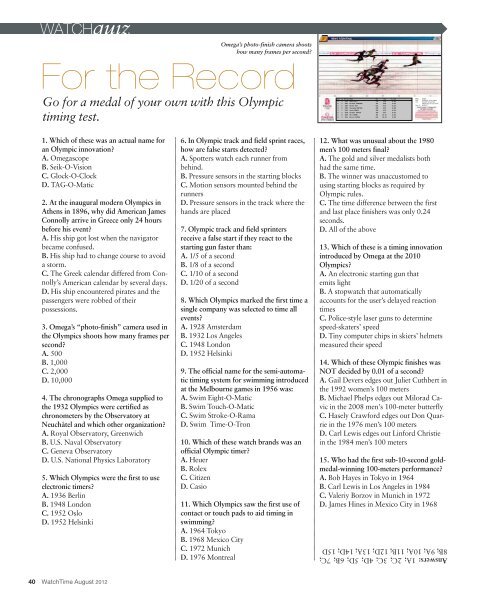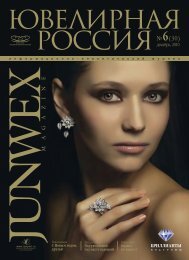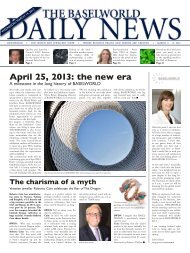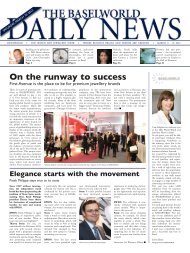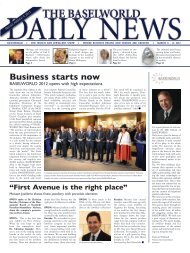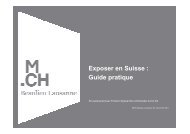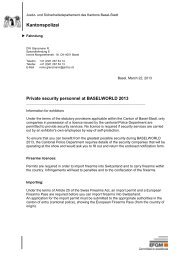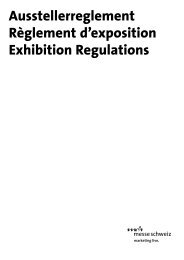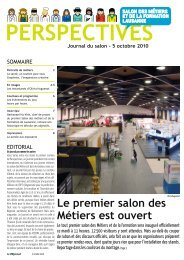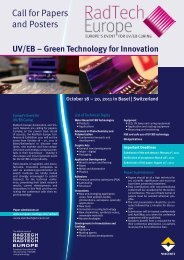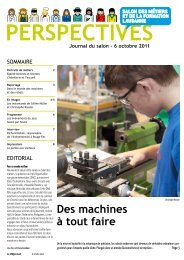WatchTime - August 2012
WatchTime - August 2012
WatchTime - August 2012
Create successful ePaper yourself
Turn your PDF publications into a flip-book with our unique Google optimized e-Paper software.
WATCHquiz<br />
For the Record<br />
Go for a medal of your own with this Olympic<br />
timing test.<br />
1. Which of these was an actual name for<br />
an Olympic innovation?<br />
A. Omegascope<br />
B. Seik-O-Vision<br />
C. Glock-O-Clock<br />
D. TAG-O-Matic<br />
2. At the inaugural modern Olympics in<br />
Athens in 1896, why did American James<br />
Connolly arrive in Greece only 24 hours<br />
before his event?<br />
A. His ship got lost when the navigator<br />
became confused.<br />
B. His ship had to change course to avoid<br />
a storm.<br />
C. The Greek calendar differed from Connolly’s<br />
American calendar by several days.<br />
D. His ship encountered pirates and the<br />
passengers were robbed of their<br />
possessions.<br />
3. Omega’s “photo-finish” camera used in<br />
the Olympics shoots how many frames per<br />
second?<br />
A. 500<br />
B. 1,000<br />
C. 2,000<br />
D. 10,000<br />
4. The chronographs Omega supplied to<br />
the 1932 Olympics were certified as<br />
chronometers by the Observatory at<br />
Neuchâtel and which other organization?<br />
A. Royal Observatory, Greenwich<br />
B. U.S. Naval Observatory<br />
C. Geneva Observatory<br />
D. U.S. National Physics Laboratory<br />
5. Which Olympics were the first to use<br />
electronic timers?<br />
A. 1936 Berlin<br />
B. 1948 London<br />
C. 1952 Oslo<br />
D. 1952 Helsinki<br />
40 <strong>WatchTime</strong> <strong>August</strong> <strong>2012</strong><br />
Omega’s photo-finish camera shoots<br />
how many frames per second?<br />
6. In Olympic track and field sprint races,<br />
how are false starts detected?<br />
A. Spotters watch each runner from<br />
behind.<br />
B. Pressure sensors in the starting blocks<br />
C. Motion sensors mounted behind the<br />
runners<br />
D. Pressure sensors in the track where the<br />
hands are placed<br />
7. Olympic track and field sprinters<br />
receive a false start if they react to the<br />
starting gun faster than:<br />
A. 1/5 of a second<br />
B. 1/8 of a second<br />
C. 1/10 of a second<br />
D. 1/20 of a second<br />
8. Which Olympics marked the first time a<br />
single company was selected to time all<br />
events?<br />
A. 1928 Amsterdam<br />
B. 1932 Los Angeles<br />
C. 1948 London<br />
D. 1952 Helsinki<br />
9. The official name for the semi-automatic<br />
timing system for swimming introduced<br />
at the Melbourne games in 1956 was:<br />
A. Swim Eight-O-Matic<br />
B. Swim Touch-O-Matic<br />
C. Swim Stroke-O-Rama<br />
D. Swim Time-O-Tron<br />
10. Which of these watch brands was an<br />
official Olympic timer?<br />
A. Heuer<br />
B. Rolex<br />
C. Citizen<br />
D. Casio<br />
11. Which Olympics saw the first use of<br />
contact or touch pads to aid timing in<br />
swimming?<br />
A. 1964 Tokyo<br />
B. 1968 Mexico City<br />
C. 1972 Munich<br />
D. 1976 Montreal<br />
<br />
<br />
<br />
<br />
<br />
<br />
<br />
<br />
<br />
<br />
<br />
<br />
<br />
<br />
<br />
<br />
<br />
<br />
<br />
<br />
<br />
<br />
<br />
<br />
<br />
<br />
<br />
<br />
<br />
<br />
<br />
<br />
<br />
<br />
<br />
<br />
<br />
<br />
<br />
<br />
<br />
<br />
12. What was unusual about the 1980<br />
men’s 100 meters final?<br />
A. The gold and silver medalists both<br />
had the same time.<br />
B. The winner was unaccustomed to<br />
using starting blocks as required by<br />
Olympic rules.<br />
C. The time difference between the first<br />
and last place finishers was only 0.24<br />
seconds.<br />
D. All of the above<br />
13. Which of these is a timing innovation<br />
introduced by Omega at the 2010<br />
Olympics?<br />
A. An electronic starting gun that<br />
emits light<br />
B. A stopwatch that automatically<br />
accounts for the user’s delayed reaction<br />
times<br />
C. Police-style laser guns to determine<br />
speed-skaters’ speed<br />
D. Tiny computer chips in skiers’ helmets<br />
measured their speed<br />
14. Which of these Olympic finishes was<br />
NOT decided by 0.01 of a second?<br />
A. Gail Devers edges out Juliet Cuthbert in<br />
the 1992 women’s 100 meters<br />
B. Michael Phelps edges out Milorad Cavic<br />
in the 2008 men's 100-meter butterfly<br />
C. Hasely Crawford edges out Don Quarrie<br />
in the 1976 men’s 100 meters<br />
D. Carl Lewis edges out Linford Christie<br />
in the 1984 men’s 100 meters<br />
15. Who had the first sub-10-second goldmedal-winning<br />
100-meters performance?<br />
A. Bob Hayes in Tokyo in 1964<br />
B. Carl Lewis in Los Angeles in 1984<br />
C. Valeriy Borzov in Munich in 1972<br />
D. James Hines in Mexico City in 1968<br />
Answers: 1A; 2C; 3C; 4D; 5D; 6B; 7C;<br />
8B; 9A; 10A; 11B; 12D; 13A; 14D; 15D


